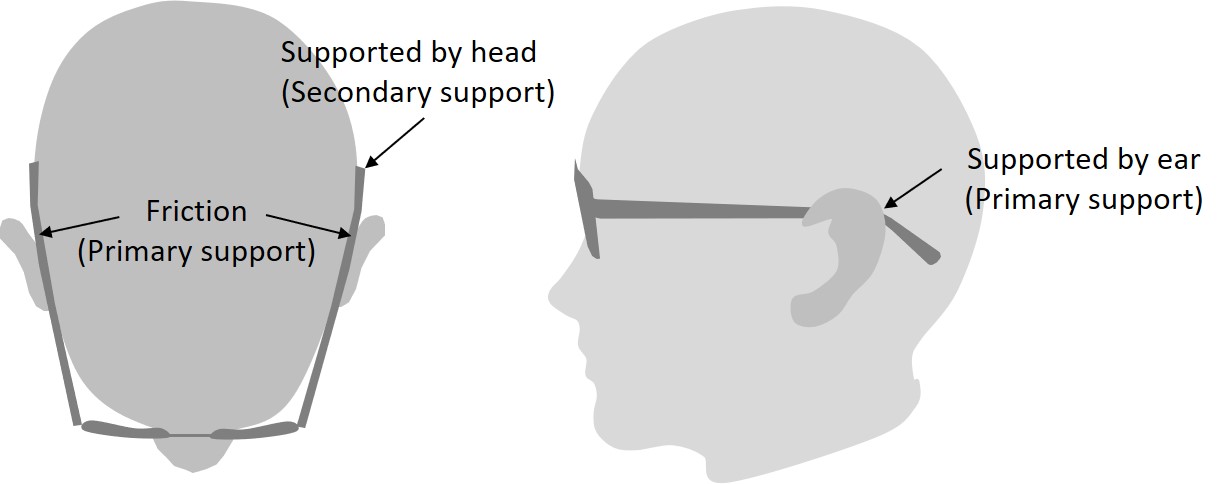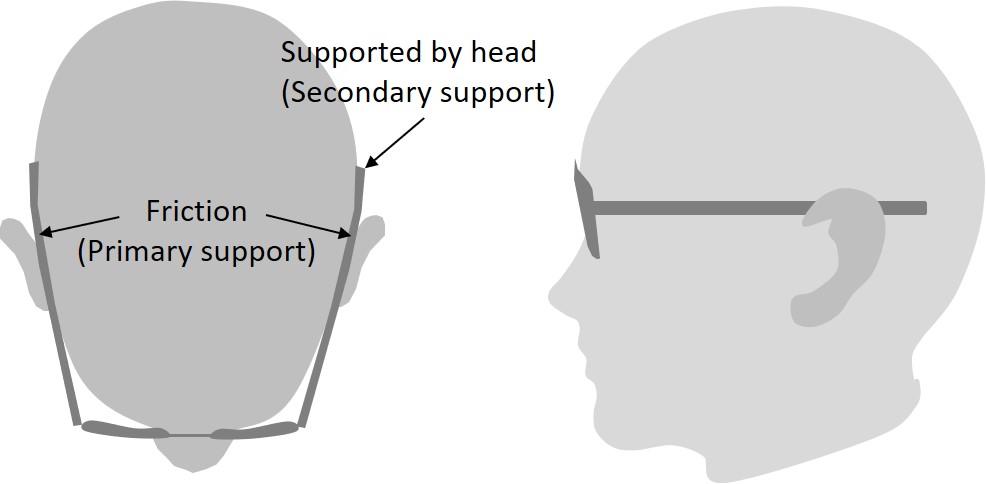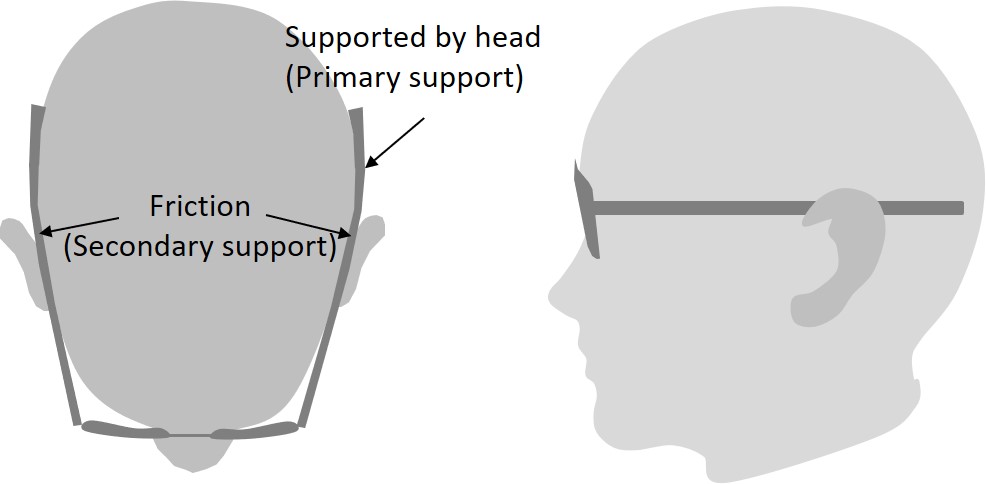Slipping glasses. Anybody who has worn glasses will know how annoying it is for the glasses to slip down. This is worse if you engage in sports or works in a humid condition. For multifocal lens, its benefits will be greatly reduced when the glasses persistently shift away from the designated position. Our frames are designed using the principle of a fitting triangle, where the frame is balanced on the nose and ears. However, this does not stop the glasses from slipping down when the face tilts downwards. The fitting triangle dictates the supporting points on the head. To keep the glasses from slipping, additional forces are needed to hold it in place. These holding forces need to be strong enough to prevent the weight of the lens from pulling the glasses down. However, the difficult part is doing this and ensuring user comfort. Any pressure points may cause soreness after many hours. This balance of force applied and comfort is trickier if the lens or the frame is heavy.
Most conventional frame uses friction as the primary support to hold the glasses on the face. Friction comes from the contact points at the temple and nosepad. Friction from the nosepad is effective when the face does not tilt down substantially. As the face tilts down, the weight of the lens gets shifted away from the nosepad and the friction reduces. Much of the holding force now depends on the temple. There are three areas of force application for the temple to hold the glasses. The first is support from friction between the temple and the side of the head. The other two are mechanical support by the ears and by the head. Most temple tip designs will have at least one primary support. They may also have secondary supports which are much weaker but still contributes to holding the glasses in place.
The skull temple design where the temple presses against the skin and down the back of the ears is the most common temple tip design. This design has a high contact area between the temple and the skin for greater friction thus friction is the primary support. The bend down the back of the ears also provides support as shown in Figure 1. The temple may also contour slightly to the back of the user's head to give it some mechanical support from the head. Careful bending is needed to reduce pressure points.

The straight or library temple may use friction forces or mechanical support by user's head to hold the glasses. On sports frame, the lenses are curved such that the contour of frame is able to effectively wrap round the face. The weight of the glasses is closer to the ears so that less force is needed to support the frame. Depending on the length of the temple, the supporting mechanism is different. A shorter temple uses the force pressing against the side of the head to generate higher friction thereby holding the glasses in place. A longer temple will curve round the back of the head such that the glasses is supported by the head. There is also friction along the length of the temple to provide additional support. For prescription glasses, there is less curvature on the lens and the temple may not be able to reach the back of the head. Therefore, it relies primarily on friction to support the glasses. See figure 2 and 3 for illustrations. Straight temple design is generally not recommended for heavy prescription lens.


The cable or curly temple is probably the most secure design with the curved temple tip to hook down the back of the ears. The weight of the glasses is supported mainly by the back of the ears with some contribution by friction as shown in figure 4. Unfortunately, this design is unpopular as it may cause discomfort to the user if the temple tip squeezes the ear. It is also not possible to make any adjustments to the curvature of the temple tip.

Current temple designs either provide too little supporting forces or does not distribute the supporting forces well enough as shown in Table 1. A better design will ensure optimum force is applied across different supporting points such that there is a greater cumulative force without increasing pressure. The anchor tip by Beta-Simplicity aims to distribute the forces across multiple supporting points as shown in figure 5. It features a uniquely designed soft rubber tip covering a metal core. The rubberized tip maximizes friction at the temple contact points. An extended loop on the temple tip is added to touch the back of the user's ear for support while ensuring the force is light enough for comfort. Having an adjustable metal core allows the temple tip to be bent along the contour of the head for some additional support. The thick and soft rubber also facilitates force distribution to minimize pressure. The combination and distribution of forces applied from this temple tip design ensures that the glasses will hold better on the user's face with more comfort.
Table 1. Summary of force application to hold glasses on the face.
"*" denotes hypothetical holding force ("*" - least force, NA - Not applicable)
| Friction | Supported by ear | Supported by head | |
|---|---|---|---|
| Skull Temple | ** | ** | * |
| Straight Temple Short | *** | NA | * |
| Straight Temple Long | ** | NA | *** |
| Curly Temple | * | ******* | NA |
| Anchor Tip Temple | *** | *** | * |

As myopia patients are getting younger, progression of their myopia will mean that their lens will get heavier. The past few decades have seen little advancement in the support mechanics of frames. Most frame temple designs either provide insufficient supporting force or concentrate the supporting force to just one area. Beta-Simplicity Anchor tip was designed to increase the supporting force from friction and the holding force behind the ear so that there is minimal increase in pressure. Such innovation in eyewear frame design will encourage greater use of glasses instead of driving users to more invasive alternatives.
02 July 2019